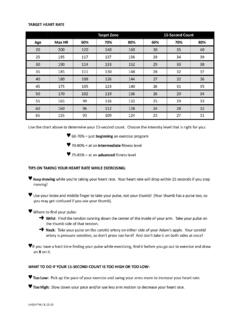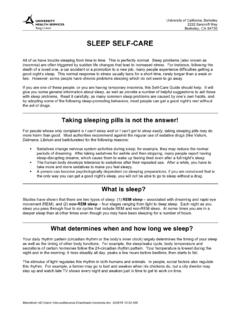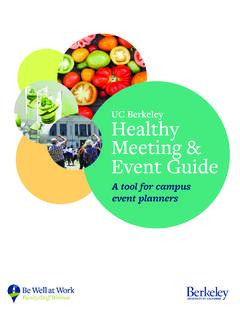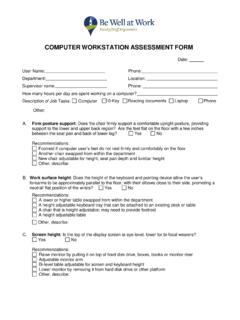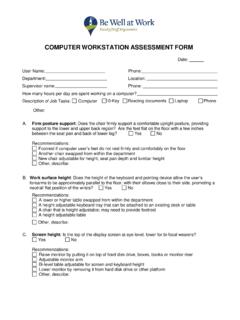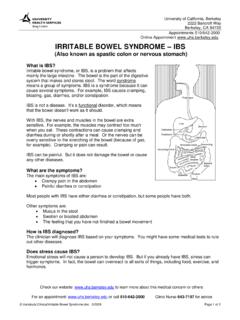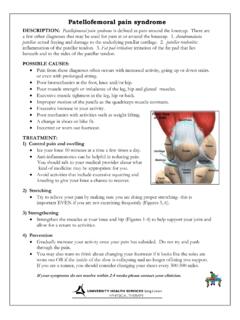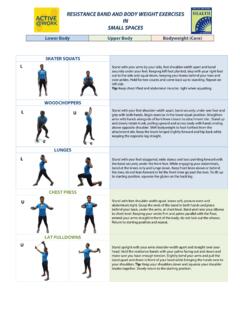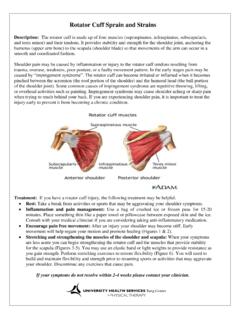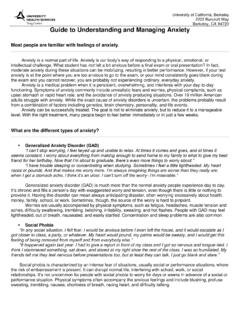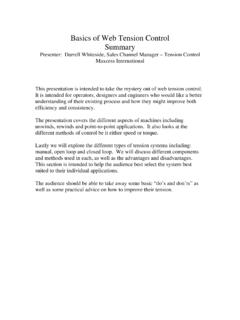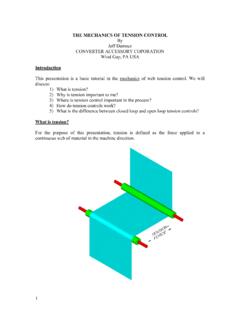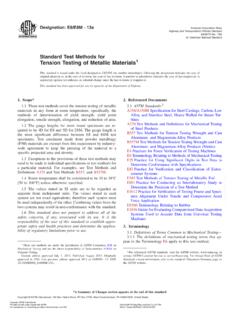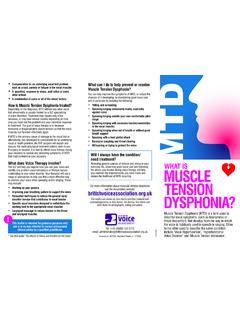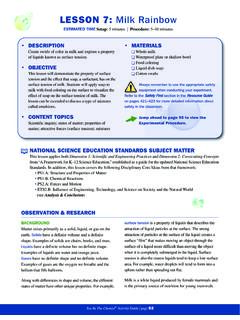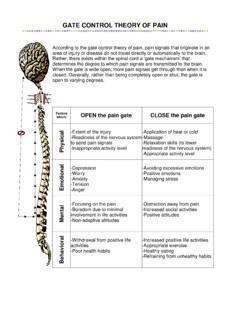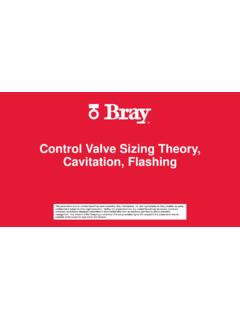Transcription of HEADACHES
1 University of California, Berkeley 2222 Bancroft Way Berkeley, CA 94720 Appointments 510/642-2000 Online Appointment Check our website: to learn more about this medical concern or others. For an appointment or call 510-642-2000 Clinic Nurse 510-643-7197 for advice S:\Handouts\Clinical\ 3/2009 HEADACHES HEADACHES are a common health problem. When severe, they can affect quality of life and lessen productivity in school and in the workplace. HEADACHES are often treatable with medications and/or lifestyle changes. Your UHS clinician is available to evaluate your symptoms and help you find strategies for headache relief. tension and migraine HEADACHES are the two most common types. These two types often overlap in their symptoms and their response to medication.
2 Modes of relief and triggering factors vary from person to person. Typical tension headache symptoms may include: Dull, steady pain with a tight band-like or vise-like gripping pressure Pain intensity is mild compared to migraine Pain may be felt in the forehead, temples, back of neck or throughout the head Muscles in the back of the upper neck may feel knotted and tender to the touch Symptoms usually subside within a few hours tension HEADACHES are often associated with stress, fatigue or muscle strain. Activities that put the head and neck in a tense, prolonged posture ( reading, keyboarding, gum chewing or teeth grinding) can trigger tension HEADACHES . Migraine characteristics include: Pain typically on one side of the head Pain has a pulsating or throbbing quality Moderate to intense pain affecting daily activity Nausea or vomiting Sensitivity to light and sound Attacks last 4 to 72 hours, sometimes longer Visual disturbances or aura ( wavy lines, dots, flashing lights and blind spots or disruptions in smell, taste or touch) from 20-60 minutes before onset of headache Exertion ( climbing stairs or running) worsens the headache.
3 Migraine HEADACHES are three times more common in women than in men. Family history of migraine is present in 70-80% of sufferers. Many women experience migraines related to the hormonal changes of menstruation, oral contraceptives, pregnancy, post-partum and menopause. If HEADACHES become more frequent and intense with oral contraceptive use, it is important to inform your clinician. In some instances, a change in the type of oral contraceptive pill will lessen or alleviate the HEADACHES . In other instances, the pill or hormone treatment must be discontinued. Over the counter or prescription medications are often useful in pain management of migraines. It is possible however, to worsen HEADACHES with frequent medication use. Talk with your clinician about all prescription, over the counter or herbal products you are taking for headache treatment.
4 Your clinician will work with you to try to find the best strategy for headache relief and prevention. Many people find headache improvement with relaxation and other self-care techniques. Rest in a darkened room, cool compresses, massage and a nap are examples. Drink plenty of fluids to avoid dehydration. Common headache triggers include: Stress or strong emotion Nuts and peanut butter Smoke, perfume or chemical orders Bright lights Aspartame artificial sweetener Sardines, anchovies, picked herring MSG Freshly baked yeast products Eye strain (if you wear glasses, make sure your prescription is current Low blood sugar Chocolate Sour cream or yogurt Lack of sleep or oversleeping Caffeine (although coffee can also relieve a migraine) Weather changes Red wine, champagne, beer Cured meat ( hot dogs, bacon) Keeping a headache diary helps you to determine which factors might influence your headache pattern.)
5 The diary allows you to list date, duration, trigger factors, treatments and time until relief of headache. Bring the diary with you to your medical visit to help your clinician determine treatment options. A sample headache diary is included on the back of this handout. Internet resources for headache information: University of California, Berkeley 2222 Bancroft Way Berkeley, CA 94720 Appointments 510/642-2000 Online Appointment Check our website: to learn more about this medical concern or others. For an appointment: or call 510-642-2000 Clinic Nurse 643-7197 for advice S:\Handouts\Clinical\ 7/9/2014 Guide to Managing Migraines Migraine Overview More than 28 million Americans suffer from migraines.
6 Migraine HEADACHES typically occur between the ages of 15 to 55, and 70-80% of migraine sufferers have a family member with migraines. Migraine HEADACHES are three to four times more common in women than in men. The higher incidence of migraines in women may be related to hormonal changes, including ovulation, menstruation, oral contraceptives, pregnancy, and menopause. Migraines can lead to both physical pain and emotional suffering. When migraines are unpredictable, frequent, or chronic, a sufferer may become frustrated, sad, angry, or depressed. When severe, migraines can affect one s quality of life and lessen productivity in school and in the workplace. Migraines, however, are treatable and preventable. Caring, supportive friends, family, co-workers and health care providers can help lessen the pain of migraine sufferers.
7 People with migraines can also help themselves by learning about their HEADACHES , building a good working relationship with their health care provider, and practicing personal self-care. Typical migraine characteristics include: Pain on one side of the head Pain with a pulsating or throbbing quality Moderate to intense pain affecting daily activity Nausea or vomiting Sensitivity to light and sound Attacks lasting 4 to 72 hours, sometimes longer Increased pain with exertion ( climbing stairs) Approximately one-fifth of migraine sufferers experience auras. An aura is characterized by the appearance of warning signs 30-60 minutes before the onset of headache symptoms. Aura symptoms are usually neurologic in nature and may include visual disturbances ( seeing wavy lines, dots, flashing lights, blind spots) and disruptions in smell, taste, or touch.
8 According to the American Medical Association: The exact cause of migraine is uncertain, although various theories are being studied. One theory favored by many researchers is that migraine is due to a vulnerability of the nervous system to sudden changes in either your body or the environment around you. Many researchers believe that migraine sufferers have inherited a more sensitive nervous system response than those without migraine. During a migraine attack, changes in brain activity produce inflamed blood vessels around the brain. Migraine medication may produce relief by quieting sensitive nerve pathways and reducing the inflammation process. S:\Handouts\Clinical\ 7/9/2014 Migraine treatment and prevention Migraine treatments are often categorized as pharmacological (treatment with drug therapy) and non-pharmacological (treatment without medications).
9 Drug therapy Many migraine medications are available. Some medications are used to stop a migraine attack (abortive therapy). These drugs work best if taken as soon as the attack begins. Other drugs are taken daily to reduce the frequency and duration of migraines (prophylactic therapy). Your clinician can provide information on your medication options and help you determine if prophylactic medication would be helpful in your situation. If HEADACHES occur at or around your menses or become more frequent and intense with oral contraceptives, talk with your clinician. It is sometimes helpful to try the following over-the-counter medicine 2-3 days before the anticipated headache and continue through your menstrual cycle: Aleve (naproxen): 1-2 tablets (220-440 mg) every 12 hours Motrin (ibuprofen): 400-800 mg every 8 hours Non-pharmacological strategies Non-pharmacological options include strategies we can employ for ourselves as well as treatments used by trained practitioners.
10 Your clinician may be able to provide referrals; some resources are also listed on the back page of this handout. These strategies can be helpful for preventing attacks as well as managing chronic migraines. Lifestyle changes Understanding how lifestyle impacts the severity and frequency of migraine attacks can be a large part of successful migraine prevention. The key is to develop consistent patterns for all days of the week. Lifestyle changes should be undertaken gradually and over time. Below is a list of proven strategies: Sleep: Maintain consistent sleep patterns, including on weekends and holidays. Learn how much sleep you need and try not to get too much or too little. Not getting enough sleep during the week and trying to get extra sleep on the weekend may trigger an attack.
